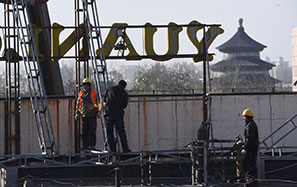Economic growth change is the 'new normal'
Two issues concerning the "new normal" state of the Chinese economy deserve special attention. First, why is a mega policy stimulus not needed? Second, what will be the driving force for structural transformation of the economy?
Three reasons explain why a large stimulus is not necessary.
Despite the slowing of the economy, unemployment is not a major concern in China today. Official statistics show the latest monthly employment rate is improving. Had GDP not grown around 7.5 percent before 2007, unemployment would have been much more serious. Now China doesn't need to create so many jobs as before, because the working-age population is shrinking, and China's industrial structure is changing from one dominated by heavy chemical and manufacturing industries to one dominated by the service sector. Labor-intensive service industries create more jobs than capital-intensive heavy industries.
The Chinese economy's leverage ratio has been rising rapidly since 2009. China's total debt-to-GDP ratio, or its M2/GDP ratio is lower than those of many developed countries, but is higher than those of most developing countries. A high leverage ratio tends to increase financial risks. A high leverage ratio is a problem especially with local government financing vehicles and in the real estate market. The room available to increase the leverage ratio is much smaller than it was before 2008.
The government's debt outlook will face upward pressures in the next few decades, given the pension financing gap, the rise in health care costs and the expenditure associated with cleaning up the environment. Experience shows that a fast increase in the financial leverage ratio often ends up in a form of a higher government debt later. Given that other factors will likely push the government debt/GDP ratio closer to its limit, the room to continue to increase the leverage ratio is limited.
Another noteworthy point of the new normal state is the structural transformation of the economy. Historically, people look to the government to "adjust" the economic structure. We are familiar with the "key industries, strategic industries and emerging industries" determined by the authority. Under the new normal state, the economic structure will be shaped more by the market force, and in particular, change in consumer preferences.
Three factors will shape the structural transformation of the Chinese economy in the future.
The rise of labor costs in China will be faster than many developing countries for many years to come. By 2030, the working-age population in China will decrease by nearly 10 percent, while the working-age population will rise by 17 percent in India, 15 percent in Indonesia and 4 percent in Vietnam.
The deceleration and relocation of China's labor-intensive industries to other countries are an irreversible trend. It is unrealistic and unsustainable to "save" some lower-end manufacturing industries through short-term stimulus policies. Another important aspect of the demographic factor is the aging of the population. In the coming 16 years, the old age population (defined as age 60 years or above) in China will increase by 70 percent. Medical expenditure incurred by the elderly is four to eight times that of young people. Obviously, in the coming decades, the health industry will grow much faster than the overall economy.
And consumers' preferences are changing. China's per capita GDP has already hit $7,000. International experience shows that after a country's per capita GDP surpasses this threshold, consumer preference tends to shift rapidly away from manufactured goods to services. The service sector's share in GDP in many developed economies rose 10 percentage points while their per capita GDP grew from $7,000 to $20,000. China will not be an exception. Therefore, healthcare, education, information technology, sports, and the cultural and entertainment industries will all enjoy great potential for rapid growth. Real estate, the automobile industry and the construction materials' industry, on the other hand, will likely face a prolonged period of profit deceleration and weaker investment in the medium and longer run.
The popular demand for cleaning up the environment and tackling the food security issue have also become a major driving force for restructuring the economy. The proportion of heavy, polluting industries in economy will decrease. Cleaner energies will replace conventional coal to cut emissions. And public transportation, especially subways, should and will see rapid growth, as it is an important way to fight air pollution and reduce traffic congestion.
The author is chief economist with the People's Bank of China.


















